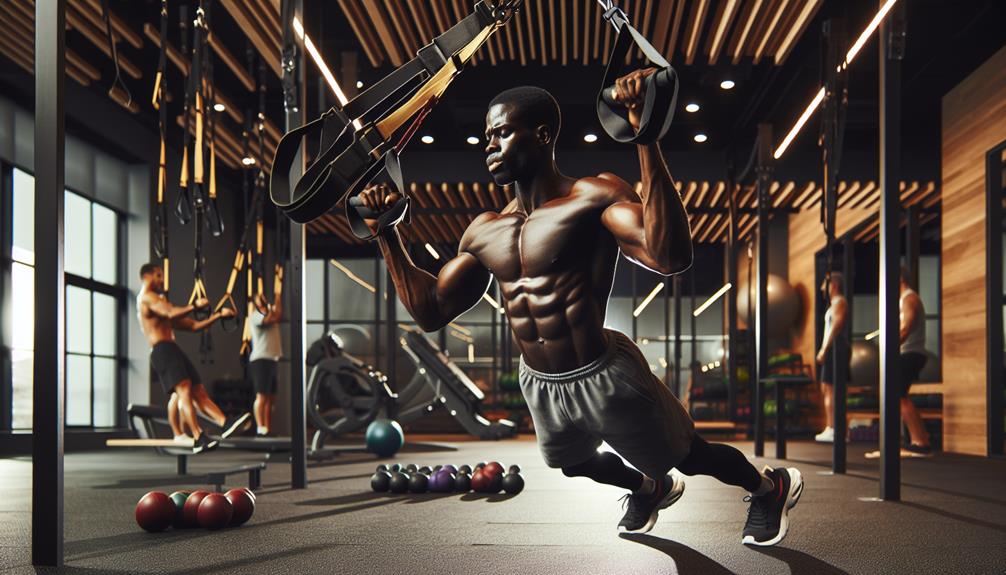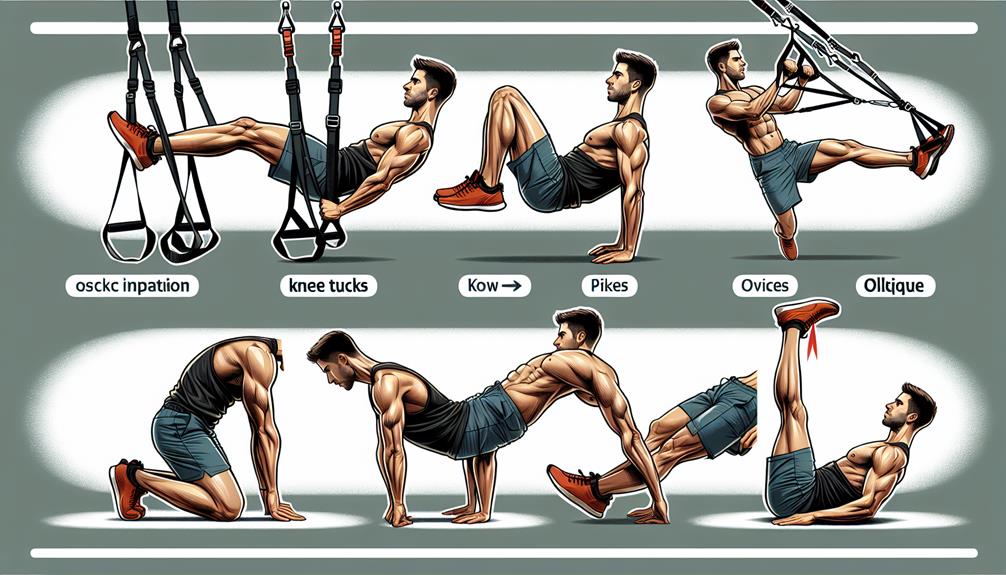When it comes to strengthening your midsection effectively, we recommend using suspension trainer core training plans. These workouts provide improved stability, engage core muscles constantly, and target multiple muscle groups simultaneously. To get started, securely anchor the suspension trainer, adjust the straps, and position the handles at chest height. Engage deep core muscles and focus on functional strength with our beginner routine. For those looking to challenge themselves, incorporate unilateral exercises and dynamic movements in the intermediate routine. Advanced users can expect intricate movements and heightened stability demands. Ready to take your core workout to the next level?
Benefits of Suspension Trainer Core Workouts
Suspension trainer core workouts offer a multitude of benefits, enhancing both strength and stability. Improved stability is a key advantage of incorporating suspension training into your core workout routine. The unstable nature of the suspension trainer forces the core muscles to engage constantly to maintain balance and control throughout the exercises. This leads to improved stability not only in the core but also in the entire body, as the core plays a crucial role in overall stability and balance.
Furthermore, suspension trainer core workouts contribute to increased strength. The variety of exercises that can be performed with a suspension trainer target multiple muscle groups simultaneously, including the core, arms, legs, and back. This results in a comprehensive strength-building workout that challenges the muscles in a unique way. By adjusting the body angle and position during exercises, individuals can customize the intensity to match their strength levels, making suspension training suitable for beginners to advanced fitness enthusiasts seeking to enhance their strength and overall fitness.
Essential Equipment and Setup
To properly engage in suspension trainer core workouts, it is crucial to have the necessary equipment and set it up correctly for optimal effectiveness. Proper equipment setup ensures safety and enhances the benefits of the exercises. Here is a table outlining the essential equipment and setup tips:
| Equipment | Setup |
|---|---|
| Suspension Trainer | Securely anchor to a sturdy overhead structure. Adjust the straps to the desired length. |
| Handles | Ensure handles are attached securely. They should be at chest height for most exercises. |
| Foot Cradles | Adjust foot cradles to an appropriate height for exercises involving leg movements. |
When setting up the equipment, make sure all components are in good condition and properly assembled. Before starting your workout, double-check the stability of the suspension trainer to prevent accidents. When using the equipment, maintain proper technique by engaging your core muscles throughout the exercises. Following these equipment setup and technique guidelines will help you get the most out of your suspension trainer core workouts.
Targeted Muscles and Benefits

Engaging in suspension trainer core workouts targets specific muscle groups and offers a range of benefits for overall strength and stability. When utilizing a suspension trainer, we focus on enhancing core stability through functional movements, which are crucial for various daily activities and sports performance. Here are some key targeted muscles and benefits of incorporating suspension trainer core exercises into your routine:
- Core Stability: Suspension trainer workouts engage deep core muscles, including the transverse abdominis and obliques, promoting better postural alignment and stability.
- Functional Movements: By mimicking real-life movements, such as pushing, pulling, and rotating, these exercises improve overall coordination and muscle activation.
- Strength Gains: Working with a suspension trainer challenges your core and other muscle groups simultaneously, leading to increased strength and endurance.
- Injury Prevention: Strengthening the core muscles can help reduce the risk of injuries, especially in the lower back and hips, by improving overall body mechanics and stability.
Beginner Suspension Trainer Core Routine
When starting a beginner suspension trainer core routine, it's important to establish a strong foundation for developing core stability and strength. Core stability is crucial as it not only helps in performing daily activities but also improves athletic performance. Our focus on functional strength through this routine will enhance overall body control and stability.
To begin, start with basic exercises such as plank variations, where the suspension trainer can be used to modify intensity. Moving on to exercises like knee tucks and body saws will engage the core muscles effectively. It's essential to maintain proper form throughout the routine to prevent injury and maximize results.
Intermediate Suspension Trainer Core Routine
How can we advance our core training with an intermediate suspension trainer routine? As we progress in our fitness journey, incorporating new challenges is crucial to continue strengthening our midsection. An intermediate suspension trainer routine introduces stability challenges and requires more advanced progression strategies to keep pushing our core to new heights.
Here are four key elements to consider when designing an intermediate suspension trainer core routine:
- Unilateral Exercises: Incorporate single-arm or single-leg movements to enhance stability requirements and engage smaller stabilizing muscles.
- Increased Range of Motion: Extend the range of motion in exercises like suspended planks or pikes to deepen the muscle engagement and improve core strength.
- Dynamic Movements: Integrate dynamic movements such as mountain climbers or knee tucks to add a cardio element while further challenging core stability.
- Time Under Tension: Focus on slowing down the movements and increasing the time under tension to intensify the core workout and enhance muscle endurance.
Advanced Suspension Trainer Core Routine
To progress further in core training and challenge our midsection effectively, an advanced suspension trainer core routine introduces intricate movements and heightened stability demands, elevating the intensity of the workout. This advanced routine focuses on enhancing core stability through a series of dynamic and challenging exercises that target deep abdominal muscles. By incorporating advanced movements such as suspended pikes, atomic push-ups, and pendulum swings, this routine pushes the limits of core engagement, requiring increased strength and control to execute each movement with precision.
Intensity progression in this advanced routine is achieved by integrating unilateral movements, adding resistance, or incorporating plyometric elements to traditional exercises. These variations not only enhance core strength but also improve overall stability and balance. Engaging in this advanced suspension trainer core routine regularly can lead to significant improvements in core strength, posture, and athletic performance. Remember, as you advance in your training, always prioritize proper form and alignment to prevent injury and maximize the benefits of each exercise.
Tips for Progression and Variation

In our pursuit of advancing core strength and stability, exploring various ways to progress and diversify our routine is crucial for continued growth and challenge. To enhance our core stability and functional movement, incorporating advanced progressions and creative variations can take our suspension trainer core training to the next level.
Here are some tips to help you progress effectively:
- Increase Resistance: Adjust the angle or length of the suspension trainer straps to add more resistance and intensify the exercise.
- Unilateral Movements: Perform exercises that focus on one side of the body at a time to improve balance and core stability.
- Plyometric Exercises: Incorporate explosive movements like jumping or quick transitions to enhance power and functional movement patterns.
- Mixed Modalities: Combine suspension trainer exercises with other equipment like dumbbells or kettlebells to create a diversified and challenging workout routine.
Frequently Asked Questions
Can Suspension Trainer Core Workouts Help Improve Posture?
Yes, suspension trainer core workouts can improve posture by enhancing stability and increasing strength. Engaging in these exercises regularly can lead to better alignment and reduced strain on the body, ultimately promoting good posture.
Are Suspension Trainer Core Exercises Suitable for Individuals With Lower Back Pain?
Suspension trainer core exercises can aid in pain management for those with lower back issues. Modifications may be needed, like adjusting intensity and range of motion. Approximately 80% of adults experience lower back pain, highlighting the relevance of this topic.
How Often Should Suspension Trainer Core Workouts Be Incorporated Into a Fitness Routine?
We recommend integrating suspension trainer core workouts 2-3 times weekly for optimal core stability. This frequency promotes muscle activation, enhancing strength and balance. Consistency in these routines yields benefits like improved posture and reduced risk of injuries.
Can Suspension Trainer Core Exercises Help Prevent Injuries in Other Areas of the Body?
Absolutely, suspension trainer core exercises are fantastic for injury prevention. By enhancing muscle stability and strengthening the core, we can protect other areas of the body during physical activities. It's a vital component of a well-rounded fitness routine.
Are There Any Specific Dietary Recommendations to Enhance the Effectiveness of Suspension Trainer Core Training?
Nutrition tips play a crucial role in maximizing the benefits of suspension trainer core training. Hydration guidelines are equally important. Consuming balanced meals rich in protein, healthy fats, and carbohydrates, alongside adequate water intake, can enhance overall performance and results.
Conclusion
In conclusion, suspension trainer core training plans are a powerful way to strengthen your midsection. By incorporating targeted exercises using this versatile piece of equipment, you can improve your stability, balance, and overall core strength.
Remember to progress gradually from beginner to advanced routines, and don't forget to vary your workouts for maximum results. With dedication and consistency, you'll soon be on your way to a rock-solid core.













